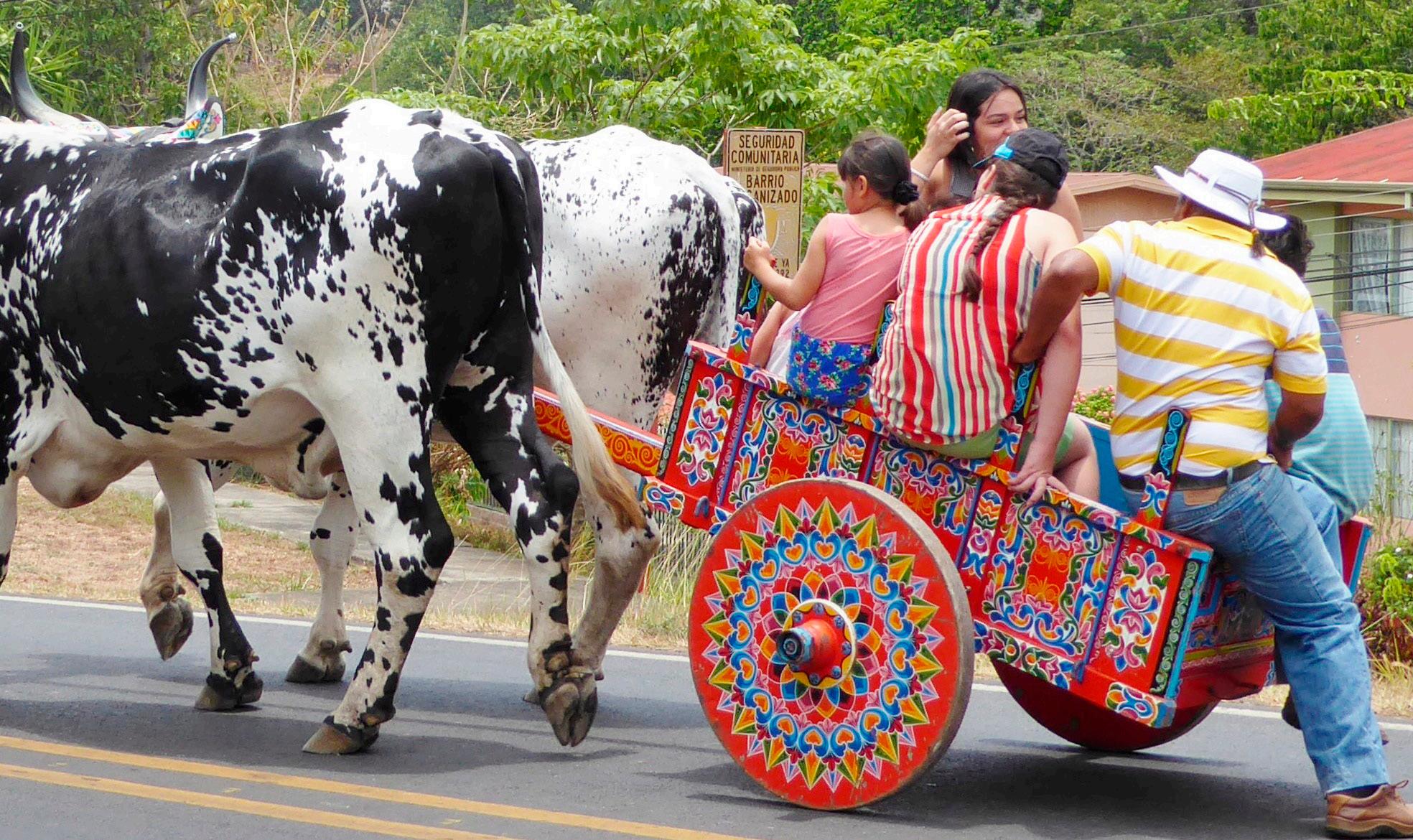
5 minute read
REGIONAL - ATENAS

Hello, I’’m Atenas
Advertisement
By Mary Martin Mason
Back in the pre-COVID-19 days, I often took taxis in San José when I went to the symphony or to restaurants. The taxista would invariably ask me where I lived. As soon as I said Atenas, the response was, “Ah, el major clima del mundo.”

The San Rafael Archangel Catholic Church, erected 1919. A local family enjoys the traditional ride in an oxen pulled cart.
“Atenas: best climate in the world” is proclaimed by realtors, on buses and in restaurant windows throughout the Central Valley. The label is attributed to a National Geographic article that never existed.
In 2016, I researched the subject for the publication Atenas Today. It turns out that a marketing committee formed over 30 years ago, led by Costa Rica’s National Chamber of Tourism (CANATUR) and the Department of Marketing, created a promotional campaign to highlight the uniqueness of various communities. While the idea was discussed to assign slogans to each province or region, ultimately it was the local residents who decided what to call themselves. The result was that Heredia became The City of Flowers, Puntarenas The Pearl of the Pacific, San Ramón The City of Poets, Grecia The Cleanest City, Alajuela The City of Mangoes and Palmares The Place to Make Friends. Best Climate in the World became the catchphrase for Atenas.
Older Costa Ricans report that as far back as pre-World War II, foreigners and nationals began to visit Atenas to experience a climate that reputedly could remedy heart conditions, asthma and other health ailments. Eventually, the citizens saw commercial opportunities in accommodating a growing number of visitors wanting to escape harsh winters. Atenas particularly appealed to retired persons who were welcomed by the town.
A reverence for elders created and sustains the local facility for the aged, Hogar de Ancianos. That regard for pensioned persons is transferred to the many retirees who now call Atenas home.
Despite its reputation for having perfect yearround weather, Atenas can get muggy. Through the years, climate change and deforestation have raised temperatures that typically hover between 68 and 89 degrees Fahrenheit. The center of town is noticeably hotter than the gated communities that perch in upper elevations.
The San Rafael Archangel Catholic Church, erected 1919. A local family enjoys the traditional ride in an oxen pulled cart.

REGIONAL - ATENAS
Today, approximately 27,000 live in Atenas and the surrounding barrios, with an estimated 8 to 10% being international visitors including Nicaraguans. The high season, November to late April, brings in about 1,000 part time folks, some who return yearly.
Location, location, location is a prime reason that expats are attracted to Atenas. Juan Santamaria International Airport is a quick halfhour jaunt, San José less than an hour by bus, and the Pacific beach town Jacó a little over an hour away by car.
Several legends exist as to how Atenas got its name. Some believe the town was named by José Rafael de Gallegos y Alvarado, a reluctant president of Costa Rica between 1833 and 1853, who preferred teaching school to governing. Another story is that when a group petitioned President Alvarado to become a town, they picked a name that would reflect his love of classical culture. Either way, a town named Atenas (Athens) and its neighbor Grecia (Greece) are in close proximity to one another.
Long before Atenas was founded, drivers and their teams of oxen transporting coffee and other products to the Caribbean and Pacific ports needed a rest stop. Sesteos, a prototype of Airbnb, began to be built. Eventually, houses, a school and San Rafael Archangel Catholic Church were erected.
Costa Rica is synonymous with the country’s artistic oxcarts, each uniquely serving as a family crest for the individual oxcart drivers (boyeros). Each April, the Atenas Oxcart Drivers Association (Asociacion Cuna del Boyero Ateniense) organizes a weekend-long Oxcart Parade and Atenas Climate Fair, sponsored by the Municipality of Atenas and the Atenas Chamber of Tourism and Commerce (CATUCA). Traditions and culture are celebrated with teams of oxen arriving from around the country, leading colorful carts in a parade. Families including grandparents and grandchildren proudly ride in the carts. An announcer in the town square provides the history of each oxcart, and various prizes are awarded.
The boyero monument, a kilometer east of central Atenas, immortalizes the town’s historic connection to the oxcart. The revered sculptor, Manuel Torrecillas Lopez or “Manolo” as he was known locally, died recently. Many gates and fences around town, as well as various statues, display his handiwork. The chandeliers hanging in San Rafael Archangel Catholic Church were his design, finished by a protégé when Lopez took ill.
The important Costa Rica tradition of the oxcart driver is celebrated each year in Atenas. The event culminates a month of cultural events in the charming Costa Rica coffee town.

The foreigners living in Atenas represent a microcosm of the politics and demographics from their respective countries, sometimes dividing and creating tension. With the closing of the Costa Rican borders as a pandemic measure, both gringos and Ticos are isolating themselves, but here in Atenas, they are not alone.

Atenas, collectively, is showing its community spirit. Locals check on their neighbors and offer medicine or grocery delivery. The supermercado, Cooperatenas, designates early hours for seniors, assuring that social distancing is enforced. Various expat groups are meeting virtually for activities such as yoga, tai chi and medication, as well as the Buddhist Book Club and the Atenas Book Club. Blogs are updated daily with the latest health statistics in Atenas and throughout Costa Rica. Readers are encouraged to remain home and practice sanitary measures.
Perhaps in the pandemic, the best characteristic of Atenas is emerging. We are a caring community.
Read more in the Howler article Atenas: The Best of Both Worlds











